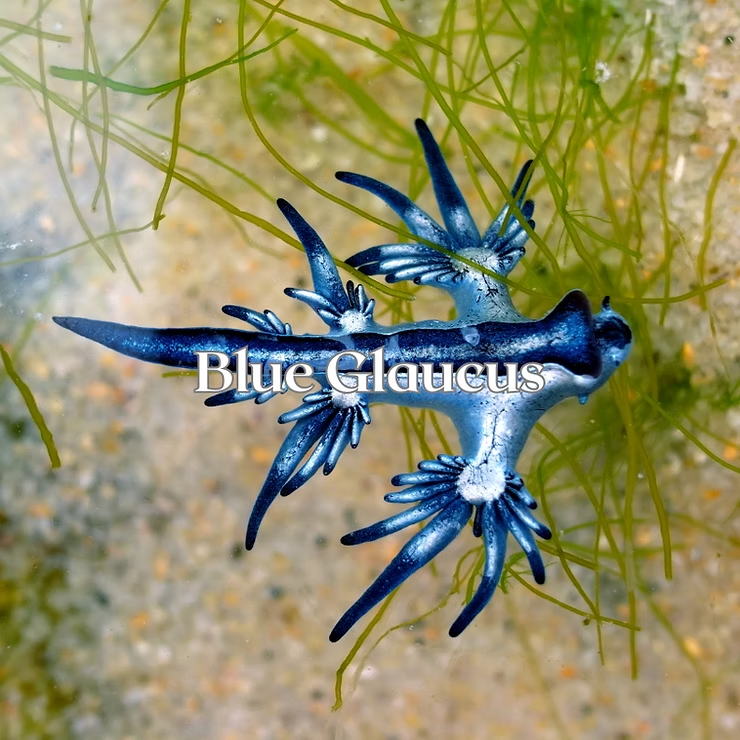Introduction
The Blue Glaucus, often called the Blue Dragon, is a captivating sea slug that has fascinated marine biologists and ocean enthusiasts alike. With its vivid colors, unusual body structure, and impressive adaptations, this small creature showcases the wonders of marine life. This article explores its appearance, habitat, diet, reproduction, adaptations, threats, and conservation status.
What is the Blue Glaucus?
Appearance and Size
The Blue Glaucus is a nudibranch that typically grows up to 3 centimeters long. Its body is flattened and tapers like a tiny dragon, making it instantly recognizable. The bright blue upper surface camouflages it against the sea surface, while the silver underside hides it from predators below.
- Vibrant blue and silver body for camouflage
- Distinct, dragon-like appearance
- Small size but striking visibility
Habitat and Distribution
This species thrives in warm and temperate oceans, particularly in the Atlantic, Pacific, and Indian Oceans. Carried by strong currents, it drifts both in open waters and along coastal areas, often appearing in shallow zones rich in plankton.
- Open ocean: Atlantic, Pacific, Indian Oceans
- Coastal waters: Often near shores and reefs
- Preferred regions: Tropical and subtropical currents
Diet and Feeding
The Blue Glaucus is best known for feeding on the Portuguese Man o’ War, a venomous jellyfish-like organism. Remarkably, it can consume stinging tentacles unharmed and store the venom in its tissues, using it for self-defense. Its radula, a specialized feeding organ, scrapes and consumes these dangerous prey items with ease.
- Feeds primarily on jellyfish, especially the Portuguese Man o’ War
- Stores venomous cells for protection
- Consumes multiple tentacles at once for efficient feeding
Reproduction and Lifespan
The Blue Glaucus is hermaphroditic, meaning each individual has both male and female reproductive organs, allowing mating flexibility. After reproduction, they produce gelatinous capsules filled with hundreds of embryos, which attach to floating objects. Their lifespan is relatively short, lasting only a few months to a year, but they reproduce frequently to ensure survival.
Unique Adaptations
Camouflage and Defense
Its dual coloration provides countershading camouflage—blue on top blending with the sea and silver below merging with sunlight. By storing nematocysts from its prey, it becomes toxic to predators such as fish, birds, and mammals.
Floating and Drifting Abilities
With a gas-filled sac in its stomach, the Blue Glaucus floats upside down at the water’s surface. This adaptation lets it drift efficiently with currents while exposing its blue side upward for protection and hunting.
Predators and Threats
Despite its defenses, the Blue Glaucus is preyed upon by larger fish, seabirds like gulls and pelicans, and marine mammals. Human activities, particularly pollution and plastic waste, also threaten its fragile existence by disrupting its habitat and food chain.
Interesting Facts
- The Blue Glaucus is a nudibranch, a group of colorful sea slugs.
- It can release stored venom when threatened, delivering a painful sting.
- Though mostly solitary, it may form swarms when food is abundant.
- It is currently classified as Least Concern by the IUCN, though pollution poses risks.
Conservation Status
While not immediately endangered, the Blue Glaucus is vulnerable to pollution, overfishing of its prey, and habitat degradation. Protecting oceans through sustainable fishing practices and pollution reduction is essential to safeguard this extraordinary species.
Conclusion
The Blue Glaucus, with its dazzling colors and remarkable adaptations, is one of nature’s most unique marine creatures. Its survival strategies, from venom storage to ocean drifting, demonstrate the ingenuity of evolution. Protecting its habitat ensures that future generations can continue to marvel at the beauty of the Blue Dragon.

